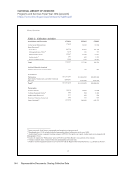59 SPEC Kit 352: Collection Assessment
Consistency and acceptance of data sources and collection methods
Resistance to evidence based/data driven collection development and management
Lack of dedicated resources and staff
Consistency and efficiency of collection data: hiring of assessment officer
Sharing of results: hiring of marketing person
Consistent data
Time
Too many locations of data
Consistent means of collecting and reporting data/findings
Strategic use of data to support institutional goals and objectives
Coordination of multiple parties’ time and effort
Cost of comprehensive assessments
Data for consortial acquisitions can be challenging to parse.
Even with data, there can be many other factors that can influence good decisions when it comes to
collection development.
Cross-departmental communication. Created position to help communicate between public and
technical services.
Lack of system interoperability
Lack of consistent usage data, changing usage standards, vendors who do not adopt usage standards.
Current integrated library system was designed for handling print materials compile data for
assessment using a variety of library and university systems.
Concerns with the reliability of vendor-supplied data double check data and disregard as necessary.
Different systems provide a different numbers, which restricts our ability to pull comparable data.
Current workflows don’t produce data that is consistently reliable or legible in the asbtract.
Current systems don’t allow robust aggregation/analysis/reporting of our collections data. Solution:
extract and manipulate the raw data using other tools.
Administrators at the university level largely deaf to evidence of need as presented by the library.
Data volume and size of collections
Lack of compliance with standards (e.g., COUNTER)
Data quality and integrity
Determining who/when is using certain e-collections more heavily (might be mediated by the use of
EZproxy logs, although there are limitations as to how deep one can go into a particular resource).
Data over time is difficult, since we have changed the ILS a number of times, and not all data was
migrated, and querying the underlying database must be done in another fashion.
Consistency and acceptance of data sources and collection methods
Resistance to evidence based/data driven collection development and management
Lack of dedicated resources and staff
Consistency and efficiency of collection data: hiring of assessment officer
Sharing of results: hiring of marketing person
Consistent data
Time
Too many locations of data
Consistent means of collecting and reporting data/findings
Strategic use of data to support institutional goals and objectives
Coordination of multiple parties’ time and effort
Cost of comprehensive assessments
Data for consortial acquisitions can be challenging to parse.
Even with data, there can be many other factors that can influence good decisions when it comes to
collection development.
Cross-departmental communication. Created position to help communicate between public and
technical services.
Lack of system interoperability
Lack of consistent usage data, changing usage standards, vendors who do not adopt usage standards.
Current integrated library system was designed for handling print materials compile data for
assessment using a variety of library and university systems.
Concerns with the reliability of vendor-supplied data double check data and disregard as necessary.
Different systems provide a different numbers, which restricts our ability to pull comparable data.
Current workflows don’t produce data that is consistently reliable or legible in the asbtract.
Current systems don’t allow robust aggregation/analysis/reporting of our collections data. Solution:
extract and manipulate the raw data using other tools.
Administrators at the university level largely deaf to evidence of need as presented by the library.
Data volume and size of collections
Lack of compliance with standards (e.g., COUNTER)
Data quality and integrity
Determining who/when is using certain e-collections more heavily (might be mediated by the use of
EZproxy logs, although there are limitations as to how deep one can go into a particular resource).
Data over time is difficult, since we have changed the ILS a number of times, and not all data was
migrated, and querying the underlying database must be done in another fashion.




















































































































































































